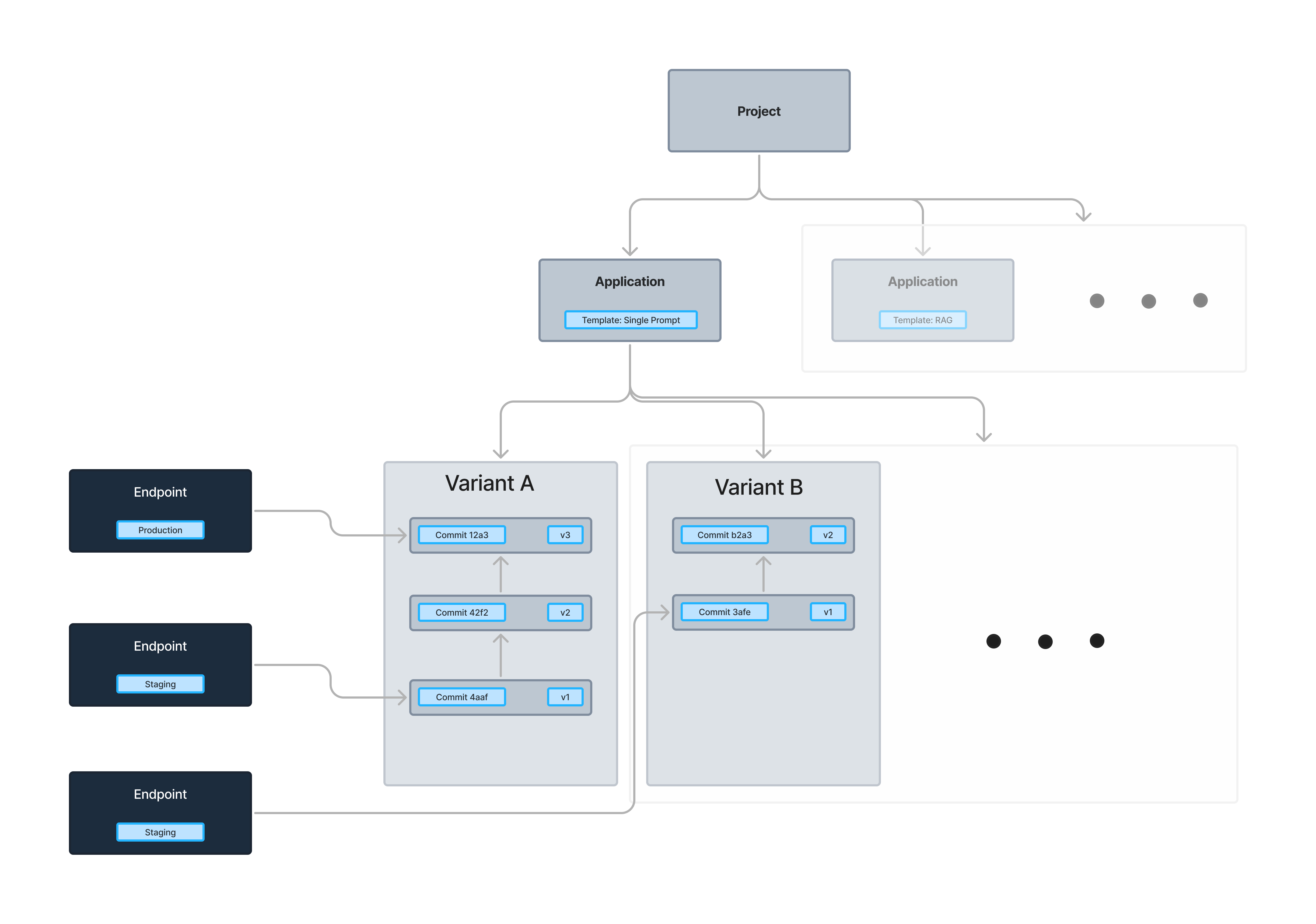Core Concepts
This page describes the main concepts used in prompt management in agenta.
Prompt and Configuration Management
What Is Prompt Management?
Building LLM-powered applications is an iterative process. In each iteration, you aim to improve the application's performance by refining prompts, adjusting configurations, and evaluating outputs.

A prompt management system provides you the tools to do this process systematically by:
- Versioning Prompts: Keeping track of different prompts you've tested.
- Linking Prompt Variants to Experiments: Connecting each prompt variant to its evaluation metrics to understand the effect of changes and determine the best variant.
- Publishing Prompts: Providing a way to publish the best prompt variants to production and maintain a history of changes in production systems.
- Associating Prompts with Traces: Monitoring how changes in prompts affect production metrics.
Why Do I Need a Prompt Management System?
A prompt management system enables everyone on the team—from product owners to subject matter experts—to collaborate in creating prompts. Additionally it helps you answer the following questions:
- Which prompts have we tried?
- What were the outputs of these prompts?
- How do the evaluation results of these prompts compare?
- Which prompt was used for a specific generation in production?
- What was the effect of publishing the new version of this prompt in production?
- Who on the team made changes to a particular prompt in production?
What Is the Difference Between Prompt and Configuration Management?
Agenta goes beyond prompt management to encompass the entire configuration of your LLM applications.
Prompts are a special case of a configuration. A prompt includes the prompt template, the model, and the model parameters. However, a configuration of an LLM application can include additional parameters.
For instance, an LLM application using a chain of two prompts would have a configuration that includes the two prompts and their respective model parameters. Similarly, an application that includes a RAG pipeline would have a configuration that includes parameters such as top_k and embedding.
Agenta enables you to version the entire configuration of the LLM app as a unit. This makes sense since there is a dependency between the parts of the configuration. For instance in a chain of two prompts, the changes of the first depend on the changes of the second. Therefore you need to version them together to ensure consistency and traceability.
Taxonomy of Terms and Concepts in agenta
Below are the description to the main terms and concepts used in agenta.

Templates
Templates are the workflows used by LLM-powered applications. Agenta comes with two default templates:
- Completion Application Template: For single-prompt applications that generate text completions.
- Chat Application Template: For applications that handle conversational interactions.
Agenta also allows you to create custom templates for your workflows using our SDK. Examples include:
- Retrieval-Augmented Generation (RAG) Applications
- Chains of Multiple Prompts
- Agents Interacting with External APIs
After creating a template, you can interact with it in the playground, run no-code evaluations, and publish versions all from the webUI.
Applications
An application uses a template to solve a specific use case. For instance, an application could use the single-prompt template for tasks like:
- Tweet Generation: Crafting engaging tweets based on input topics.
- Article Summarization: Condensing long articles into key points.
Variants
Within each application, you can create variants. Variants are different configurations of the application, allowing you to experiment with and compare multiple approaches. For example, for the "tweet generation" application, you might create variants that:
- Use different prompt phrasings.
- Adjust model parameters like temperature or maximum tokens.
- Incorporate different styles or tones (e.g., professional vs. casual).
Versions
Every variant is versioned and immutable. When you make changes to a variant, a new version is created. Each version has a commit id that uniquely identifies it.
Endpoints
Endpoints are the interfaces where your published variants are accessible. You can publish a version of a variant to an endpoint. Each endpoint has a user-defined environment name (e.g. development, staging, production) that specifies its context or stage.
You can then integrate the endpoint into your codebase to fetch the configuration published on that endpoint. Additionally, you can directly call the endpoint containing the application running with that configuration.
By default, applications come with three predefined environment names for endpoints:
- Development: For initial testing and experimentation.
- Staging: For pre-production testing and quality assurance.
- Production: For live use with real users.
When publishing a variant to an endpoint, the latest version of that variant gets published. Each endpoint points to a specific version of a variant (a certain commit). Updating the variant after publishing does not automatically update the endpoint.